SCI写作必备语法专题五 主谓一致1.0
主谓一致知识点总结
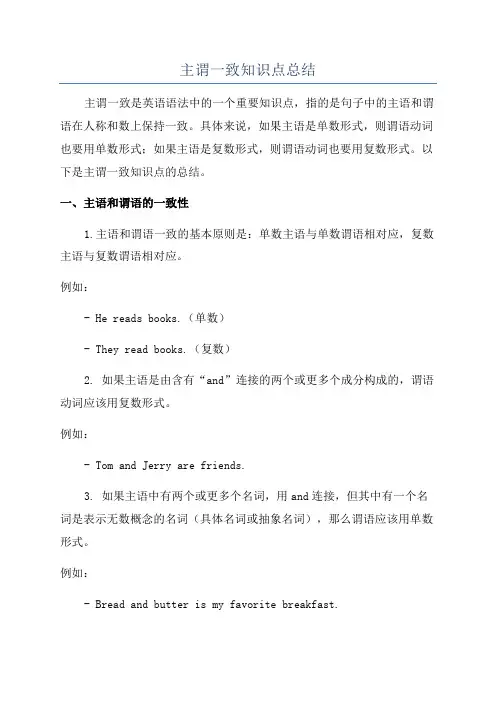
主谓一致知识点总结主谓一致是英语语法中的一个重要知识点,指的是句子中的主语和谓语在人称和数上保持一致。
具体来说,如果主语是单数形式,则谓语动词也要用单数形式;如果主语是复数形式,则谓语动词也要用复数形式。
以下是主谓一致知识点的总结。
一、主语和谓语的一致性1.主语和谓语一致的基本原则是:单数主语与单数谓语相对应,复数主语与复数谓语相对应。
例如:- He reads books.(单数)- They read books.(复数)2. 如果主语是由含有“and”连接的两个或更多个成分构成的,谓语动词应该用复数形式。
例如:- Tom and Jerry are friends.3. 如果主语中有两个或更多个名词,用and连接,但其中有一个名词是表示无数概念的名词(具体名词或抽象名词),那么谓语应该用单数形式。
例如:- Bread and butter is my favorite breakfast.4. 如果主语是由连词“either…or”或“neither…nor”连接的两个名词构成的,谓语动词的单复数应与紧挨着的名词一致。
例如:5. 如果主语是由连词“not only…but also”连接的两个名词构成的,谓语动词的单复数应与紧挨着的名词一致。
例如:- Not only the teacher but also the students are going to the park.二、主谓一致的特殊情况1. 主语是以“everyone, everybody, someone, somebody, no one, nobody, anyone, anybody, each”等单词开头的不定代词时,谓语动词应该用单数形式。
例如:- Everyone knows the answer.2. 对于由and连接的两个主语,如果它们指的是同一个人或同一个物,谓语动词应该用单数形式。
例如:- Tom and Jerry is a famous cartoon.3. 对于固定短语“a number of + 名词”,谓语动词应该用复数形式。
语法中的主谓一致原则详解
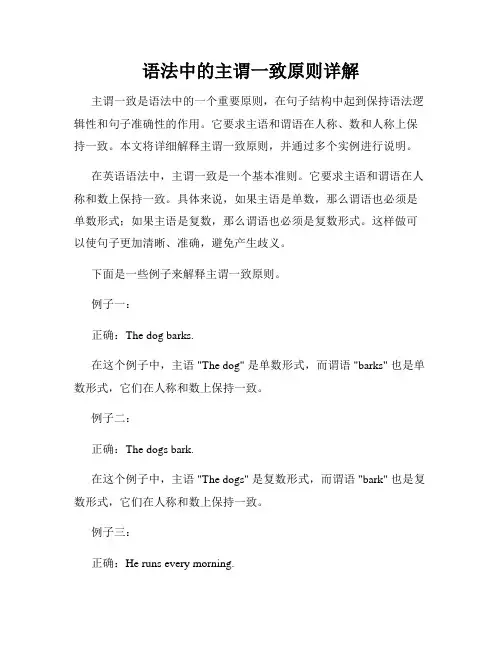
语法中的主谓一致原则详解主谓一致是语法中的一个重要原则,在句子结构中起到保持语法逻辑性和句子准确性的作用。
它要求主语和谓语在人称、数和人称上保持一致。
本文将详细解释主谓一致原则,并通过多个实例进行说明。
在英语语法中,主谓一致是一个基本准则。
它要求主语和谓语在人称和数上保持一致。
具体来说,如果主语是单数,那么谓语也必须是单数形式;如果主语是复数,那么谓语也必须是复数形式。
这样做可以使句子更加清晰、准确,避免产生歧义。
下面是一些例子来解释主谓一致原则。
例子一:正确:The dog barks.在这个例子中,主语 "The dog" 是单数形式,而谓语 "barks" 也是单数形式,它们在人称和数上保持一致。
例子二:正确:The dogs bark.在这个例子中,主语 "The dogs" 是复数形式,而谓语 "bark" 也是复数形式,它们在人称和数上保持一致。
例子三:正确:He runs every morning.在这个例子中,主语 "He" 是单数形式,而谓语 "runs" 也是单数形式,它们在人称和数上保持一致。
例子四:正确:They run every morning.在这个例子中,主语 "They" 是复数形式,而谓语 "run" 也是复数形式,它们在人称和数上保持一致。
通过这些例子,我们可以看到主谓一致的原则运用在不同类型的句子中。
无论是肯定句、疑问句还是否定句,主谓一致原则都需要被遵守。
除了人称和数,还有其他因素也会影响主谓一致的运用,比如连接词和修饰词。
例子五:正确:Either the cat or the dog is responsible for the mess.在这个例子中,主语 "Either the cat or the dog" 是单数形式,而谓语"is" 也是单数形式,两者在人称和数上保持一致。
英语语法之主谓一致

主谓一致主谓一致是指:1)语法形式上要一致,即单复数形式与谓语要一致;2)意义上要一致,即主语意义上的单复数要与谓语的单复数形式一致;3)就近原则,即谓语动词的单复形式取决于最靠近它的词语。
一般来说,不可数名词用动词单数,可数名词复数用动词复数,但当不可数名词前有表示数量的复数名词时,谓语动词用复数形式。
一、并列结构作主语时的主谓一致并列结构作主语时谓语用复数,但是当主语由and连结时,如果它表示一个单一的概念,即指同一人或同一物时,谓语动词用单数,and 此时连接的两个词前只有一个冠词。
同时,如果and连接的两个单数名词前若用each,every,no修饰,该名词短语作主语时,谓语动词也要用单数形式。
e.g. I) To mean to do something and to actually do something are two separate things.想干一件事和真干一件事是两回事。
II) The food and the textile industry depend mainly on agriculture for raw material.粮食工业和纺织工业主要靠农业提供原料。
III) The iron and steel industry is very important to our national economy.钢铁工业在国民经济中起重要作用。
IV) No book and on pencils found in the schoolbag.书包里没有书和钢笔。
二、主谓一致中的就近原则1.当there be句型的主语是一系列事物时,谓语应与最邻近的主语保持一致。
e.g. I) There is a teacher and some students in the classroom.教室里有一名老师和一些学生。
II) There are four books and a pencil box in his bag.在他的包里有四本书和一个铅笔盒。
(完整版)英语语法主谓一致
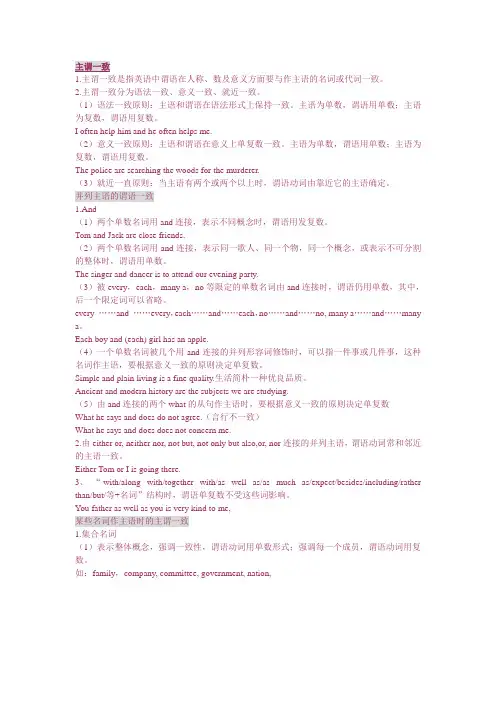
1.主谓一致是指英语中谓语在人称、数及意义方面要与作主语的名词或代词一致。
2.主谓一致分为语法一致、意义一致、就近一致。
(1)语法一致原则:主语和谓语在语法形式上保持一致。
主语为单数,谓语用单数;主语为复数,谓语用复数。
I often help him and he often helps me.(2)意义一致原则:主语和谓语在意义上单复数一致。
主语为单数,谓语用单数;主语为复数,谓语用复数。
The police are searching the woods for the murderer.(3)就近一直原则:当主语有两个或两个以上时,谓语动词由靠近它的主语确定。
并列主语的谓语一致1.And(1)两个单数名词用and连接,表示不同概念时,谓语用发复数。
Tom and Jack are close friends.(2)两个单数名词用and连接,表示同一歌人、同一个物,同一个概念,或表示不可分割的整体时,谓语用单数。
The singer and dancer is to attend our evening party.(3)被every,each,many a,no等限定的单数名词由and连接时,谓语仍用单数,其中,后一个限定词可以省略。
every ……and ……every,each……and……each,no……and……no, many a……and……many a。
Each boy and (each) girl has an apple.(4)一个单数名词被几个用and连接的并列形容词修饰时,可以指一件事或几件事,这种名词作主语,要根据意义一致的原则决定单复数。
Simple and plain living is a fine quality.生活简朴一种优良品质。
Ancient and modern history are the subjects we are studying.(5)由and连接的两个what的从句作主语时,要根据意义一致的原则决定单复数What he says and does do not agree.(言行不一致)What he says and does does not concern me.2.由either or, neither nor, not but, not only but also,or, nor连接的并列主语,谓语动词常和邻近的主语一致。
SCI科研论文写作中的语法与标点符号使用技巧
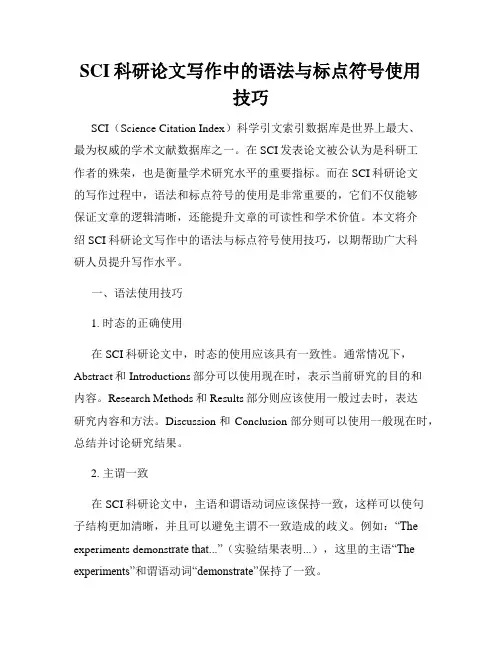
SCI科研论文写作中的语法与标点符号使用技巧SCI(Science Citation Index)科学引文索引数据库是世界上最大、最为权威的学术文献数据库之一。
在SCI发表论文被公认为是科研工作者的殊荣,也是衡量学术研究水平的重要指标。
而在SCI科研论文的写作过程中,语法和标点符号的使用是非常重要的,它们不仅能够保证文章的逻辑清晰,还能提升文章的可读性和学术价值。
本文将介绍SCI科研论文写作中的语法与标点符号使用技巧,以期帮助广大科研人员提升写作水平。
一、语法使用技巧1. 时态的正确使用在SCI科研论文中,时态的使用应该具有一致性。
通常情况下,Abstract和Introductions部分可以使用现在时,表示当前研究的目的和内容。
Research Methods和Results部分则应该使用一般过去时,表达研究内容和方法。
Discussion和Conclusion部分则可以使用一般现在时,总结并讨论研究结果。
2. 主谓一致在SCI科研论文中,主语和谓语动词应该保持一致,这样可以使句子结构更加清晰,并且可以避免主谓不一致造成的歧义。
例如:“The experiments demonst rate that...”(实验结果表明...),这里的主语“The experiments”和谓语动词“demonstrate”保持了一致。
3. 使用恰当的语法结构SCI科研论文中应该尽量使用简洁明了的语法结构,避免过度使用复杂的从句和被动语态。
简洁明了的语法结构可以使读者更容易理解研究内容。
例如:“The data shows that...”(数据显示...),比起使用被动语态“it is shown that...”(它被显示...)更加直接和简练。
二、标点符号使用技巧1. 逗号的正确使用逗号在SCI科研论文中的使用非常重要,它可以将长句分割成更加清晰明了的短句。
逗号可以用于列举、分割并列连词、区分主句和从句等。
主谓一致英语语法详细讲解
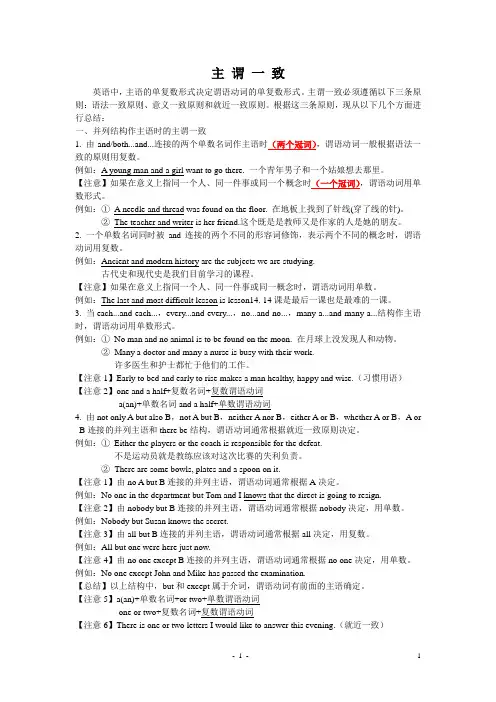
主谓一致英语中,主语的单复数形式决定谓语动词的单复数形式。
主谓一致必须遵循以下三条原则:语法一致原则、意义一致原则和就近一致原则。
根据这三条原则,现从以下几个方面进行总结:一、并列结构作主语时的主谓一致1. 由and/both...and...连接的两个单数名词作主语时(两个冠词),谓语动词一般根据语法一致的原则用复数。
例如:A young man and a girl want to go there. 一个青年男子和一个姑娘想去那里。
【注意】如果在意义上指同一个人、同一件事或同一个概念时(一个冠词),谓语动词用单数形式。
例如:①A needle and thread was found on the floor. 在地板上找到了针线(穿了线的针)。
②The teacher and writer is her friend.这个既是是教师又是作家的人是她的朋友。
2. 一个单数名词同时被and连接的两个不同的形容词修饰,表示两个不同的概念时,谓语动词用复数。
例如:Ancient and modern history are the subjects we are studying.古代史和现代史是我们目前学习的课程。
【注意】如果在意义上指同一个人、同一件事或同一概念时,谓语动词用单数。
例如:The last and most difficult lesson is lesson14. 14课是最后一课也是最难的一课。
3. 当each...and each...,every...and every...,no...and no...,many a...and many a...结构作主语时,谓语动词用单数形式。
例如:①No man and no animal is to be found on the moon. 在月球上没发现人和动物。
②Many a doctor and many a nurse is busy with their work.许多医生和护士都忙于他们的工作。
主谓一致语法总结
主谓一致语法总结主谓一致是指中文句子中的主语与谓语在人称和数上保持一致的语法规则。
即当主语为单数时,谓语动词要用单数形式;当主语为复数时,谓语动词要用复数形式。
主谓一致是语言表达准确性和语法规范性的重要组成部分,能够帮助读者或听者更好地理解句子的意思。
下面对主谓一致语法进行详细总结。
一、主谓一致的基本规则1. 主谓一致的人称与数主谓一致在人称上要求主语和谓语动词在人称上保持一致。
一般来说,第一人称(I、we)、第二人称(you)和第三人称(he、she、it、they)的主语分别对应特定的谓语动词形式,要根据不同人称选择正确的动词形式。
例句1:I am a teacher.(我是一名教师。
)第一人称单数主语 "I"对应第一人称单数谓语动词 "am"。
例句2:They are students.(他们是学生。
)第三人称复数主语 "they"对应第三人称复数谓语动词 "are"。
2. 单数主谓一致单数主语要与单数谓语动词保持一致。
单数主语可以是单个名词、不可数名词或单数名词短语。
例句3:The cat is sleeping.(那只猫正在睡觉。
)单数主语 "the cat"对应单数谓语动词 "is"。
例句4:Mathematics is my favorite subject.(数学是我最喜欢的科目。
)单数主语 "Mathematics"对应单数谓语动词 "is"。
3. 复数主谓一致复数主语要与复数谓语动词保持一致。
复数主语可以是由两个或更多名词组成的名词短语,或者是复数名词。
例句5:The books are on the shelf.(书在书架上。
)复数主语 "The books"对应复数谓语动词 "are"。
主谓一致_精品文档
主谓一致什么是主谓一致?在英语语法中,主谓一致是指主语和谓语动词在人称和数上保持一致。
这意味着当主语是单数时,谓语动词也应该是单数形式;当主语是复数时,谓语动词也应该是复数形式。
这种一致性有助于句子更加准确和流畅地表达。
主谓一致的基本规则以下是一些关于主谓一致的基本规则:1.单数主语使用单数谓语动词,如:–The dog barks at the mailman.(这只狗对邮递员吠叫。
)–She plays tennis every weekend.(她每个周末都打网球。
)2.复数主语使用复数谓语动词,如:–The dogs bark at the mailman.(这些狗对邮递员吠叫。
)–They play tennis every weekend.(他们每个周末都打网球。
)3.以单数形式的量词或不可数名词作主语时,使用单数谓语动词,如:– A lot of water is wasted every day.(每天浪费了很多水。
)–Physics is my favorite subject.(物理是我最喜欢的科目。
)4.以连接词“and”连接的多个主语时,如果主语都是单数,则使用单数谓语动词;如果主语中至少有一个是复数,则使用复数谓语动词,如:–Mary and John are going to the party.(玛丽和约翰要去参加聚会。
)–The cat and the dog play together.(猫和狗一起玩耍。
)5.当主语是以“each”、“every”、“no”、“either”、“neither”等作为前缀的词时,使用单数谓语动词,如:–Each student has a textbook.(每个学生都有一本教科书。
)–No one knows the answer.(没有人知道答案。
)注意事项在使用主谓一致时,还需要记住以下一些常见的特殊情况和注意事项:1.多个主语,但整体作为一个单位时,谓语动词的数取决于整体单元的意思,如:–Bread and butter is my breakfast.(面包和黄油是我的早餐。
高考英语语法讲解-主谓一致
语法讲解:主谓一致在英语句子里,谓语受主语支配,其动词必须和主语在人称和数上保持一致,这就叫主谓一致。
寻其规律,大致可归纳为三个原则,即语法一致、逻辑意义一致和就近一致原则。
一、语法一致原则语法上一致就是谓语动词和主语在单、复数形式上保持一致。
1.以单数名词或代词、动词不定式短语、动名词短语或从句作主语时,谓语动词一般用单数形式;主语为复数时,谓语动词用复数形式。
如:His father is working on the farm. / To study English well is not easy. / What he said is very important for us all. /The children were in the classroom two hours ago. / Reading in the sun is bad for youreyes.注意:由what引导的主语从句,后面的谓语动词多数情况用单数形式,但若表语是复数或what从句是一个带有复数意义的并列结构时,主句的谓语动词用复数形式。
如:What I bought were three English books. / What I say and do is (are)helpful to you.2. 由连接词and或both ……and连接起来的合成主语后面,要用复数形式的谓语动词。
如:Lucy and Lily are twins. / She and I are classmates. / The boy and the girl were surprised when they heard the news. / Both she and he are Young Pioneers.注意:(1)若and所连接的两个词是指同一个人或物时,它后面的谓语动词就应用单数形式。
如:The writer and artist has come. (2)由and连接的并列单数主语前如果分别有no,each,every more than a (an),many a (an)修饰时,其谓语动词要用单数形式。
语法点解析主谓一致的用法与理解
语法点解析主谓一致的用法与理解语法点解析:主谓一致的用法与理解主谓一致是英语语法中一个重要的概念,它指的是主语与谓语在人称和数方面保持一致。
准确理解和正确运用主谓一致是写作中的关键之一。
本文将对主谓一致的用法与理解进行详细解析。
一、基本概念主谓一致是指主语与谓语在人称和数方面保持一致。
当主语是单数形式,谓语动词也要用单数形式;当主语是复数形式,谓语动词也要用复数形式。
主谓一致是英语思维逻辑的体现,它使文章的表达更加准确、流畅。
二、人称一致人称一致指的是主语与谓语在人称方面保持一致。
一般情况下,第一人称的主语与谓语使用第一人称形式,第二人称的主语与谓语使用第二人称形式,第三人称的主语与谓语使用第三人称形式。
例1:I am a student. (我是一个学生)例2:You are my friend. (你是我的朋友)例3:He is a doctor. (他是一名医生)三、数的一致数的一致指的是主语与谓语在数方面保持一致。
当主语是单数形式,谓语动词也要用单数形式;当主语是复数形式,谓语动词也要用复数形式。
例4:The dog barks. (这只狗在叫)例5:The cats play in the garden. (这些猫在花园里玩耍)例6:She eats an apple. (她吃了一个苹果)四、特殊情况除了基本的人称和数一致规则外,还存在一些特殊情况需要特别注意。
1. 不可数名词:对于不可数名词作主语,谓语动词一般使用单数形式。
例7:The information is correct. (这些信息是正确的)2. 复合主语:当主语由两个或多个单数名词或代词构成,且被并列连词and连接时,谓语动词用复数形式。
例8:Tom and Jerry are friends. (汤姆和杰瑞是朋友)3. 带有either...or, neither...nor, not only...but also等连词的主谓一致:当主语由either...or, neither...nor, not only...but also引导时,谓语动词的单复数形式取决于距离谓语动词最近的名词。
- 1、下载文档前请自行甄别文档内容的完整性,平台不提供额外的编辑、内容补充、找答案等附加服务。
- 2、"仅部分预览"的文档,不可在线预览部分如存在完整性等问题,可反馈申请退款(可完整预览的文档不适用该条件!)。
- 3、如文档侵犯您的权益,请联系客服反馈,我们会尽快为您处理(人工客服工作时间:9:00-18:30)。
SCI写作必备语法专题五主谓一致一、主谓一致的种类1.语法一致主语为单数形式,谓语动词用单数形式;主语为复数形式,谓语动词也用复数形式。
如:The number of the students present is200.目前的学生数是200。
Jane and Mary look alike.简和玛丽看起来很像。
2.意义一致(1)主语形式虽为单数,但意义为复数,谓语动词用复数。
如:The crowd were shouting.人们在喊叫。
单数形式代表复数内容的词有people,police,cattle(牛,牲畜)等。
(2)主语形式为复数,而意义上却是单数,谓语动词用单数。
如:The news was so surprising.这则消息是那么得令人惊讶。
形复意单的单词有news和一些以ics结尾的学科名称,如physics,politics,economics等。
3.就近原则:即谓语动词的单、复数形式取决于最靠近它的词语。
如用连词or,either...or...,neither...nor...,not only...but also...等连接的并列主语,如果一个是单数,一个是复数,谓语动词与靠近它的主语一致。
如:Either your students or Mr.Wang knows this.要么是你的学生,要么是王老师了解这件事。
二、主谓一致的应用1.名词作主语(1)某些集体名词,如family,team等作主语时,如果作为一个整体看待,谓语动词用单数形式,如果就其中一个个成员而言,谓语动词用复数形式。
如:His family is a happy one.他的家庭是一个幸福的家庭。
The whole family are watching TV.全家人都在看电视。
这类名词有audience,class,club,company,crew,enemy,crowd,government,group,party,public,team等。
名词population一词的使用情况与之类似。
“a group(crowd)of+复数名词”等短语之后的谓语动词也同样可用单数或复数,前者强调整体,后者强调各个部分。
(2)某些集体名词,如people,police,cattle等,只当复数看待,谓语动词必须用复数。
如:The police are searching for the thief.警察正在搜捕那个贼。
(3)单、复数同形的名词作主语时,谓语动词应根据意义决定单、复数。
如:A sheep is over there.那边有只羊。
Some sheep are over there.那边有些羊。
(4)名词所有格之后的名词被省略,这种情况一般只指商店、工厂、住宅等,作主语时,动词一般用单数。
如:The doctor’s is across the street.诊所在街道的对面。
My uncle’s is not far from here.我叔叔家离这儿不远。
常见的省略名词有the baker’s,the barber’s,the carpenter’s,the Zhang’s等。
表示店铺的名词,一般作集体名词看待,但用作主语时,谓语动词往往用复数。
如:Richardson’s have a lot of goods to sell.理查德店有很多货物要卖。
5)当名词词组中心词为表示度量、距离、金额、时间、书名等复数名词时,往往可以根据意义一致的原则,把这些复数名词看作一个整体,谓语用单数形式。
如:Three years has passed since then.自从那时到现在,三年已经过去了。
6)不定代词each,every,no所修饰的名词即使以and或逗号连接成多主语时,谓语动词仍用单数形式。
如:Each boy and each girl wants to go to the cinema.孩子们都想去看电影。
7)如果主语有more than one...或many a...构成,尽管从意义上看是复数内容,但它的谓语动词仍用单数形式。
如:More than one student has read the book.很多学生读过这本书。
但是,“more+复数名词+than one”结构之后,谓语动词一般多用复数形式。
如:More members than one are against your plan.许多成员反对你的计划。
8)一些有两个部分构成的名词表示衣物或工具作主语时,谓语动词通常用复数形式。
如:glasses,clothes,trousers,shoes,compasses(指南针或者是罗盘),chopsticks,scissors等。
但如果主语用“a kind of,a pair of,a series of等加名词”构成时,谓语动词一般用单数形式。
如:A pair of shoes was on the desk.桌子上有一双鞋。
9)this kind of book=a book of this kind(这种书),其谓语动词用单数;短语this kind of men=men of this kind(这一类人),但this kind of men的谓语动词用单数,men of this kind 谓语动词用复数,all kinds of后跟复数名词,谓语动词用复数形式。
如:This kind of men is dangerous.这一种人很危险。
Men of this kind are dangerous.这种类型的人很危险。
10)复数形式的单、复数同形名词作主语时,按意义一致原则,用作单数意义时,谓语用单数,反之,谓语用复数。
这类名词有means(方法),works(工厂),species(种类),Chinese,Japanese等。
如:The(This)glass works was set up in1980.这家玻璃厂建于1980年。
The(These)glass works are near the railway station.这些玻璃厂在火车站附近。
当它们前面有a,such a,this,that修饰时,谓语用单数;有all,such,these,those修饰时,谓语用复数;但means,no means,the means等词前没有以上修饰词时,可用作单数,也可用作复数。
11)如果名词词组中心词是all,most,half,rest等词语,所指的复数意义,谓语动词用复数形式;反之,用单数。
如:All of my classmates like music.我的同学都喜欢音乐。
All of the water is gone.所有的水都没了。
12)在主谓倒装的句子中,谓语动词的数应与其后的主语一致。
如:Between the two windows hangs a picture.两窗户间挂着一幅画。
2.由连接词连接的名词作主语1)用and或both...and连接并列主语,谓语动词通常用复数形式。
如:Plastics and rubber never rot.橡胶和塑料永不腐烂。
Walking and riding are good exercises.散步和骑车是很好的运动。
但是,并列主语如果指的是同一个人、同一事物或同一概念时,谓语动词用单数形式,这时and后面的名词没有冠词。
如:To love and to be loved is great happiness.爱与被爱是种幸福。
Going to bed early and getting up early is a good habit.早睡早起是种好习惯。
A knife and fork is on the table.桌子上有副刀叉。
2)当主语后面跟有as well as,as much as,no less than,along with,with,like,rather than,together with,but,except,besides,including,in addition to等引导的词组时,其谓语动词的单、复数据这些词前面的主语而定。
如:The teacher as well as the students was reading in the library.老师和学生都在图书馆里看书。
3)以or,either...or,neither...nor,not only...but also等连接的名词(代词)作主语时,谓语动词的单复数应根据就近一致的原则。
如:Tom or his brothers are waiting in the room.汤姆和哥哥们在房间里等着。
3.代词作主语1)名词性物主代词作主语时,既可以用作单数,也可以用作复数,这取决于它所代替的是单数还是复数。
如:Ours(Our Party)is a great party.我们的党是个伟大的党。
2)such,the same起指示代词作用时,应根据其所指的内容来决定单、复数。
如:Such is our plan.Such are his words.那就是我们的计划。
那就是他的话。
3)关系代词who,that,which等在定语从句中作主语时,其谓语动词的数应与句中先行词的数一致。
如:Those who want to go please put up your hands.想去的请举手。
Some of the energy that is used by man comes from the sun.人类使用的一些能源来自太阳。
4)疑问代词who,what,which作主语时,谓语动词可根据说话人所要表达的意思决定单、复数。
如:Who lives next door?It is Xiao Liu.谁住在隔壁?是小刘。
What produce(s)heat?什么产生热量?5)不定代词any,either,neither,none,all,some,more等作主语时,有以下两种情况:单独作主语时,视其在文中的意义,动词用单数或复数形式,例如:Now all has been changed.现在一切都改变了。
All are present.所有人都到场了。
either,neither单独作主语时,谓语通常用单数。
但后接of时,若of的宾语为不可数名词,动词当然用单数形式,若of的宾语为复数名词或代词时,动词可以是单数,也可以是复数,在正式文体中,单数形式的动词更常用。
如:Do(es)any of you know his address?你们当中有谁知道他的地址吗?None of them has(have)seen the film.他们当中没人看过这部电影。
